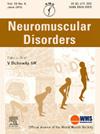Management of presymptomatic juvenile patients with late-onset Pompe disease (LOPD)
IF 2.7
4区 医学
Q2 CLINICAL NEUROLOGY
引用次数: 0
Abstract
Late-onset Pompe disease (LOPD) includes patients from 1 year of age to adulthood. The vast heterogeneity in clinical manifestations and disease progression is not fully explained; however, a short disease duration and a young age seem to be good predictors of a better response to treatment. For this purpose, we investigated and followed up a cohort of 13 juvenile patients with LOPD from the clinical and therapeutic point of view, mainly pointing out the transition from presymptomatic to symptomatic status.
We retrospectively collected clinical, morphological, biochemical and molecular data from 13 juvenile LOPD patients. Motor and respiratory functional data, obtained during annual follow-up visits, were analyzed. The data included serial evaluations of the Medical Research Council (MRC) scale, the 6-Minute Walking Test (6MWT), the Gait, Stairs, Gower, and Chair (GSGC) score, and seated and supine Forced Vital Capacity (FVC). Muscle Magnetic Resonance Imaging (MRI) was also included, although it was not performed in all cases.
Currently, patients mean age is 18 years. All patients but one were diagnosed because of an isolated hyperCKemia: the mean age at diagnosis was 6.8 years (range 1–18). The onset of symptoms occurred from 6 months to 12 years after the diagnosis. The mean clinical follow-up duration was 9 years (range 2–18). From the genetic point of view, the most shared mutation was c.32–13T>G, found in twelve patients as compound heterozygosis. Seven patients underwent muscle biopsy, which showed vacuolar myopathy with glycogen accumulation in four of them with unspecific changes in the other three cases. Five patients developed proximal muscle weakness during the follow-up with a mild waddling gait and a positive Gowers manoeuver. Muscle MRI revealed mild hypotrophy of the thighs at the development of symptoms in four out of five cases. Four patients started alglucosidase alfa, and one avalglucosidase alfa. These five patients on Enzyme Replacement Therapy (ERT) showed motor and respiratory stability in the following years.
Timely identification of emerging clinical manifestations in presymptomatic LOPD patients, as a result of careful follow-up, is essential to start prompt treatment to modify the disease natural course.
症状前青少年迟发性庞贝病(LOPD)患者的治疗。
迟发性庞贝病(LOPD)包括从1岁到成年的患者。临床表现和疾病进展的巨大异质性尚未得到充分解释;然而,病程短和年龄小似乎是对治疗有更好反应的良好预测指标。为此,我们从临床和治疗的角度对13例青少年LOPD患者进行了调查和随访,主要指出从症状前到症状状态的转变。我们回顾性收集了13例青少年LOPD患者的临床、形态学、生化和分子资料。对每年随访期间获得的运动和呼吸功能数据进行分析。数据包括医学研究委员会(MRC)量表、6分钟步行测试(6MWT)、步态、楼梯、高尔和椅子(GSGC)评分以及坐位和仰卧用力肺活量(FVC)的一系列评估。肌肉磁共振成像(MRI)也包括在内,尽管并非所有病例都进行了检查。目前,患者的平均年龄为18岁。除1例外,所有患者均因孤立性高血血症被诊断:诊断时的平均年龄为6.8岁(范围1-18岁)。症状发生在诊断后6个月至12年。平均临床随访时间为9年(范围2-18年)。从遗传角度来看,共有12例患者的c.32-13T>G突变为复合杂合。7例患者行肌肉活检,其中4例显示空泡性肌病伴糖原积聚,另外3例出现非特异性改变。5例患者在随访期间出现近端肌肉无力,步态轻微摇摇摆摆,高尔斯动作积极。肌肉MRI显示,在症状发展时,五分之四的患者大腿轻度萎缩。4例患者开始使用α葡萄糖苷酶,1例开始使用α葡萄糖苷酶。这5名接受酶替代治疗(ERT)的患者在随后的几年中表现出运动和呼吸稳定。及时识别症状前LOPD患者的新临床表现,通过仔细的随访,对于及时开始治疗以改变疾病的自然进程至关重要。
本文章由计算机程序翻译,如有差异,请以英文原文为准。
求助全文
约1分钟内获得全文
求助全文
来源期刊

Neuromuscular Disorders
医学-临床神经学
CiteScore
4.60
自引率
3.60%
发文量
543
审稿时长
53 days
期刊介绍:
This international, multidisciplinary journal covers all aspects of neuromuscular disorders in childhood and adult life (including the muscular dystrophies, spinal muscular atrophies, hereditary neuropathies, congenital myopathies, myasthenias, myotonic syndromes, metabolic myopathies and inflammatory myopathies).
The Editors welcome original articles from all areas of the field:
• Clinical aspects, such as new clinical entities, case studies of interest, treatment, management and rehabilitation (including biomechanics, orthotic design and surgery).
• Basic scientific studies of relevance to the clinical syndromes, including advances in the fields of molecular biology and genetics.
• Studies of animal models relevant to the human diseases.
The journal is aimed at a wide range of clinicians, pathologists, associated paramedical professionals and clinical and basic scientists with an interest in the study of neuromuscular disorders.
 求助内容:
求助内容: 应助结果提醒方式:
应助结果提醒方式:


